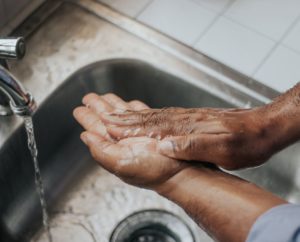As more people than ever turn their attention to what they put into their bodies, an increasing number of shoppers are thinking twice about what they put onto their bodies. Clean beauty labels have gained traction in some of the country's largest personal care retailers, with brands producing natural soaps, moisturizers, shampoos and more to meet the demand. But as quickly as clean beauty products are developed and introduced, so are GMO-based equivalents.
The Butterfly lands lightly on your skin
Did you know your skin is the largest organ in your body? It plays a vital role in keeping you healthy, acting as a barrier against physical injury and toxins. Many people choose skincare products carefully because the ingredients are absorbed through their skin. Some products on the market make unverified non-GMO claims or contain ingredients created using new GMO techniques. That's how GMOs can sneak into consumers' shopping carts — and their epidermis.
For example, spider silk is a sought-after — if surprising — ingredient in personal care and medicine. Historically, it's been gathered naturally and used to bandage and treat wounds. In skincare products, spider silk proteins act as a barrier to lock in moisture. But spider silk is difficult to harvest. It can be made synthetically using genetically modified yeast. In the short time this technology has been available, dozens of brands have begun using GMO spider silk proteins as a luxurious signature ingredient in face creams and moisturizers.
Several other products on the market — or poised to enter the market — are derived from GMOs. The first genetically modified human collagen was created specifically for use in cosmetics. GMOs are also found in fragrances added to products. Genetically modified rose oil, for example, is created by inserting the rose’s genome into yeast. This kind of technology is not limited to skin care products — it has entered the supply chain of the beauty industry as a whole. This prevalence is driving consumers to seek out clean makeup brands.
 GMOs hiding in beauty products and skincare
GMOs hiding in beauty products and skincare
Not only is there a risk of GMOs made from new genetic engineering techniques, but many skincare and makeup ingredients are made with traditional GMOs. Crops that are high risk for GMOs — such as canola, corn and soy — are processed into oils to be used in products including moisturizers and soaps.
When high risk ingredients are listed simply and clearly — such as “soybean oil” or “corn starch” — consumers who keep up to date on our high risk list would recognize them. But complicated labeling can make it hard to know where GMOs are hiding.
Here's a product comparison of 2 moisturizers. The potential hiding places for GMOs are in bold:
| Non-GMO Project Verified Moisturizer | Conventional Moisturizer |
|---|---|
| Organic Shea Butter, Organic Cocoa Butter, Organic Coconut Oil, Organic Olive Oil and Organic Jojoba Oil | Water, Avocado Oil, Cocoa Butter, Glycerin, PEG-100 Stearate, Glyceryl Stearate, Cetearyl Alcohol, Palm Oil, Almond Oil, Soybean Oil, Dimethicone, Fragrance, Phenoxyethanol (preservative), Xanthan Gum, Vitamin E, Benzyl Alcohol, Citric Acid |
The unverified product presents GMO risks from soybean oil, corn-based alcohol, fragrance, xanthan gum and citric acid made from genetically modified microorganisms.
Finding non-GMO shampoos, soaps, moisturizers & more
To avoid ingredients made from traditional GMOs and new genetic engineering techniques in conventional products, look for the Butterfly and check out the 65 brands that produce over 700 Non-GMO Project Verified products, from moisturizers and oils, to shampoos and soaps, to lip gloss and more!
